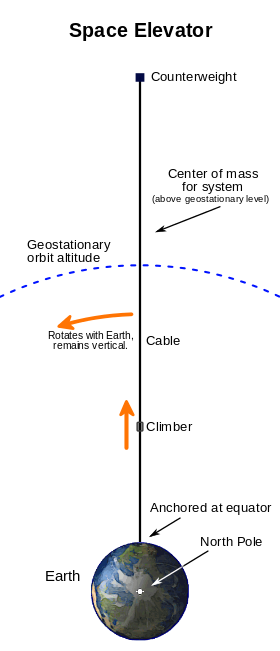Science Seen Physicist and Time One author Colin Gillespie helps you understand your world.
Going Up?
 It is ‘an engineering project on a gargantuan scale.’ So says American physicist, P.K. Aravind. ‘By far the largest megaproject ever undertaken,’ says another American physicist, Adam Brown. Each is writing of an antigravity device called a space elevator. The picture shows how it’s supposed to work. The centrifugal pull of a counterweight holds up a long cable that is anchored to Earth at the equator. In turn the cable keeps the Earth-circling counterweight in place. A climber with a motor can move up and down the cable. In this article we’ll ask: What’s wrong with this picture?
It is ‘an engineering project on a gargantuan scale.’ So says American physicist, P.K. Aravind. ‘By far the largest megaproject ever undertaken,’ says another American physicist, Adam Brown. Each is writing of an antigravity device called a space elevator. The picture shows how it’s supposed to work. The centrifugal pull of a counterweight holds up a long cable that is anchored to Earth at the equator. In turn the cable keeps the Earth-circling counterweight in place. A climber with a motor can move up and down the cable. In this article we’ll ask: What’s wrong with this picture?
The idea of cheap space travel is seductive. Even NASA once supported a space-elevator program. It makes a fantastic story. Devised by Russian engineer Yuri Artsutanov, promoted by British science-fiction writer Arthur C. Clarke, it’s a concept we all want to work. Will it get us into space and save us money? No, it won’t.
See for yourself. Board the climber. Together with a three-ton communications satellite we will climb the cable 36,000 km (22,000 miles) to geostationary orbit altitude (G.O.; the dashed line). When we get to G.O. we will pop the comsat out the hatch. To stay up in G.O. it must circle Earth in 24 hours, which means an orbital speed of 3 km/s (7,000 mi/hr).
Let’s think energy. Lifting it to G.O. gives it (and us) potential energy. This comes from work done by the elevator’s motor. But what about kinetic energy? To keep the cable straight in G.O. we must be moving 5.6 times faster to the left than we were moving with the Earth’s rotation on the ground. We now have 30 times more kinetic energy. Where did that come from? The laws of physics say there’s no free lunch.
Let’s take a closer look. As we leave the surface, Earth’s rotation has us moving left at 500 m/s (1,000 mi/hr). To stay over the anchor, we must move left faster as we rise. We need a push to get us up to speed. The cable is like a stretched string. When it’s straight it can’t push sideways. Pushing us to the left gives it a right-side kink, like a bowstring. The kink does several things. It yanks the counterweight down. And it tugs the counterweight toward the right. But the weight’s momentum tries to keep it at the same speed in the smaller orbit. So (counter-intuitively) the counterweight moves left. The cable’s lift decreases and its kink gets bigger. The structure is unstable. We never get to G.O. The cable is soon winding round the Earth as we come crashing down.
It’s a physics problem. Brown says:
For a theoretical physicist like me, once you have decided that a proposed structure does not actually violate the known laws of physics, everything else is just engineering.
Unfortunately this structure builds a free ride with some laws of physics by neglecting others. We can solve the problem. We can fire a rocket from the right-hand window with the exact thrust that will speed us up to keep the cable straight, so that the rocket gets us going round the Earth. This could be smaller than the rocket needed to get the satellite into G.O. without the elevator. But the elevator will have lost its whole Look-Ma-No-Rocket point. And it will still be unstable.
NASA still has its sights set on rocket travel. Rockets are expensive. But they’re far less costly than ‘the largest megaproject ever’. And—their greatest virtue—rockets work.
Coming: Does phony physics concern you?
Sources:
Padmanabhan Aravind (2007), “The physics of the space elevator”, Am. J. Phys., vol. 75, p. 125; http://users.wpi.edu/~paravind/Publications/PKASpace%20Elevators.pdf
Adam Brown (2015), “Can We Mine a Black Hole?”, Scientific American, New York, February issue, p. 44; http://www.scientificamerican.com/article/could-black-hole-energy-save-humanity-s-future/
Other Reading:
Yuri Artsutanov (1960), “V Kosmos na Elektrovoze”, Komsomolskaya Pravda, Moscow: Izdatelsky Dom Komsomolskaya Pravda, July 31
Arthur C. Clarke (1979), The Fountains of Paradise, London: Victor Gollancz, http://www.amazon.com/The-Fountains-Paradise-Arthur-Clarke/dp/1480535591
Image Source:
Wikipedia, “Space Elevator”, http://en.wikipedia.org/wiki/Space_elevator

No comments yet.